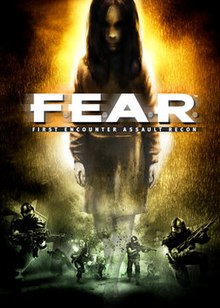| F.E.A.R. First Encounter Assault Recon | |
|---|---|
 PC cover art | |
| Developer(s) | Monolith Productions[a] |
| Publisher(s) | Vivendi Universal Games[b] |
| Director(s) | Craig Hubbard |
| Producer(s) |
|
| Designer(s) | Craig Hubbard |
| Programmer(s) |
|
| Artist(s) |
|
| Writer(s) | Craig Hubbard |
| Composer(s) | Nathan Grigg |
| Series | F.E.A.R. |
| Engine | LithTech Jupiter EX |
| Platform(s) | |
| Release | WindowsXbox 360PlayStation 3 |
| Genre(s) | First-person shooter, psychological horror[9][10][11] |
| Mode(s) | Single-player, multiplayer |
F.E.A.R. First Encounter Assault Recon is a 2005 first-person shooter psychological horror video game for Windows, PlayStation 3, and Xbox 360. Developed by Monolith Productions and published by Vivendi Universal Games, the Windows version was released worldwide in October 2005. The Xbox and PlayStation versions were ported by Day 1 Studios and released in October 2006 and April 2007, respectively. Two standalone expansion packs were released for the Windows and Xbox 360 versions of the game, both developed by TimeGate Studios; F.E.A.R. Extraction Point (2006) and F.E.A.R. Perseus Mandate (2007). Released on Windows in March 2007, F.E.A.R. Gold Edition includes all the content from the Director's Edition plus Extraction Point, while F.E.A.R. Platinum Collection, released for Windows in November 2007, includes the Director's Edition, Extraction Point, and Perseus Mandate. Neither expansion is now considered canon, as the Monolith-developed F.E.A.R. 2: Project Origin ignores the events of both.
The game's story revolves around the fictional F.E.A.R. (First Encounter Assault Recon) unit, an elite group in the United States Army tasked with investigating supernatural phenomena. When a private military company's secret research program goes wrong and a dangerous and powerful psychic is unleashed, F.E.A.R. is called in, with the player taking on the role of the unit's newest recruit, Point Man. However, it soon becomes apparent there is much more going on than a rogue psychic as Point Man finds himself facing a lethal and unpredictable paranormal menace in the form of a young girl with extraordinary destructive power.
Although the atmosphere of the game was heavily influenced by Japanese horror, Monolith's primary goal with F.E.A.R was to make the player feel like the hero of an action film. To this end, they combined a slow-motion technique called "reflex time", a semi-destructible environment, and a highly detailed particle system in an attempt to create as immersive an environment as possible. Another vital element in this is the game's AI, with Monolith employing a never-before-used technique to give hostile NPCs an unusually broad range of actions in response to what the player is doing. This results in NPCs who can also work as a team, such as performing flanking maneuvers, laying down suppressive fire, and attempting to retreat when under heavy fire.
Upon its initial Windows release, F.E.A.R. was very well received, with the AI garnering especial praise. Critics also lauded the graphics, atmosphere, sound design, music, and combat mechanics. Common points of criticism were a lack of enemy variety, a weak plot, and repetitive level design. The Xbox 360 version was also well received, but the PlayStation 3 version met with mixed reviews, with many critics unimpressed with the port's technical issues and graphical inferiority. It was a commercial success, selling over three million units worldwide across all three systems.
- ^ Surette, Tim (October 17, 2005). "VU says F.E.A.R. is H.E.R.E." GameSpot. Archived from the original on September 17, 2021. Retrieved September 17, 2021.
- ^ Bramwell, Tom (October 18, 2005). "F.E.A.R. patched to 1.01". Eurogamer. Archived from the original on September 17, 2021. Retrieved September 17, 2021.
- ^ "F.E.A.R. (Xbox 360)". amazon.au. Archived from the original on September 29, 2021. Retrieved September 29, 2021.
- ^ Brudvig, Erik (October 24, 2006). "Retail Getting Twice the F.E.A.R.". IGN. Archived from the original on October 1, 2021. Retrieved October 1, 2021.
- ^ "F.E.A.R. (Xbox 360)". amazon.co.uk. Archived from the original on September 29, 2021. Retrieved September 29, 2021.
- ^ Sinclair, Brendan (March 28, 2007). "F.E.A.R. gets a date with PS3". GameSpot. Archived from the original on October 1, 2021. Retrieved October 1, 2021.
- ^ Emma, Boyes (March 29, 2007). "Europe feels the F.E.A.R. early". GameSpot. Archived from the original on August 8, 2021. Retrieved August 8, 2021.
- ^ Kolan, Patrick (March 29, 2007). "F.E.A.R. Gets AU Release Date". IGN. Archived from the original on October 2, 2021. Retrieved October 2, 2021.
- ^ Purchese, Robert (March 24, 2010). "F.3.A.R to be revealed next month". Eurogamer. Archived from the original on January 24, 2023. Retrieved January 24, 2023.
- ^ Sanchez, David (October 9, 2013). "GameZone's 31 Games of Halloween 2013: F.E.A.R.". GameZone. Archived from the original on January 24, 2023. Retrieved January 24, 2023.
- ^ Pursey, Jack (April 23, 2022). "13 Best Psychological Horror Games". GameRant. Archived from the original on January 24, 2023. Retrieved January 24, 2023.
Cite error: There are <ref group=lower-alpha> tags or {{efn}} templates on this page, but the references will not show without a {{reflist|group=lower-alpha}} template or {{notelist}} template (see the help page).